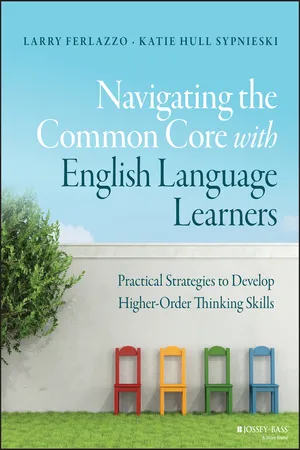
Navigating the Common Core with English Language Learners
Practical Strategies to Develop Higher-Order Thinking Skills
- English
- ePUB (mobile friendly)
- Available on iOS & Android
Navigating the Common Core with English Language Learners
Practical Strategies to Develop Higher-Order Thinking Skills
About This Book
The must-have Common Core guide for every ESL/ELL instructor
Navigating the Common Core with English Language Learners is the much-needed practical guide for ESL/ELL instructors. Written by experienced teachers of English Language Learners, this book provides a sequel to the highly-regarded ESL/ELL Teacher's Survival Guide and is designed to help teachers implement the Common Core in the ELL classroom. You'll find a digest of the latest research and developments in ELL education, along with comprehensive guidance in reading and writing, social studies, math, science, Social Emotional Learning and more. The Common Core is discussed in the context of ESL, including the opportunities and challenges specific to ELL students. Ready-to-use lesson plans and reproducible handouts help you bring these ideas into the classroom, and expert guidance helps you instill the higher-order thinking skills the Common Core requires.
The Common Core standards have been adopted in 43 states, yet minimal guidance has been provided for teachers of English Language Learners. This book fills the literature gap with the most up-to-date theory and a host of practical implementation tools.
- Get up to date on the latest stats and trends in ELL education
- Examine the challenges and opportunities posed by Common Core
- Find solutions to common issues that arise in teaching ELL students
- Streamline Common Core implementation in the ELL classroom
The ELL population is growing at a rapid pace, and the ELL classroom is not exempt from the requirements posed by the Common Core State Standards. ESL/ELL teachers know better than anyone else how critical language is to learning, and ELL students need a specialized Common Core approach to avoid falling behind. Navigating the Common Core with English Language Learners provides specific guidance and helpful tools that teachers can bring to the classroom today.
Frequently asked questions
Information
Chapter One
English Language Learners and the Common Core: An Overview
Change is the law of life. And those who look only to the past or present are certain to miss the future.
ELL Population Growth
Languages Spoken by ELLs
How Are English Language Learners Described?
An individual who, due to any of the reasons listed below, has sufficient difficulty speaking, reading, writing, or understanding the English language to be denied the opportunity to learn successfully in classrooms where the language of instruction is English or to participate fully in the larger U.S. society....
Table of contents
- Cover
- More Praise for Navigating the Common Core with English Language Learners
- Title Page
- Copyright
- Table of Contents
- About the Authors
- About the Contributors
- Acknowledgments
- Introduction
- Chapter 1: English Language Learners and the Common Core: An Overview
- Chapter 2: Creating the Conditions for English Language Learners to Be Successful in the Common Core Standards
- Chapter 3: Reading
- Chapter 4: Writing
- Chapter 5: Speaking and Listening
- Chapter 6: Language
- Chapter 7: Mathematics
- Chapter 8: Social Studies
- Chapter 9: Science
- Appendix
- Index
- End User License Agreement